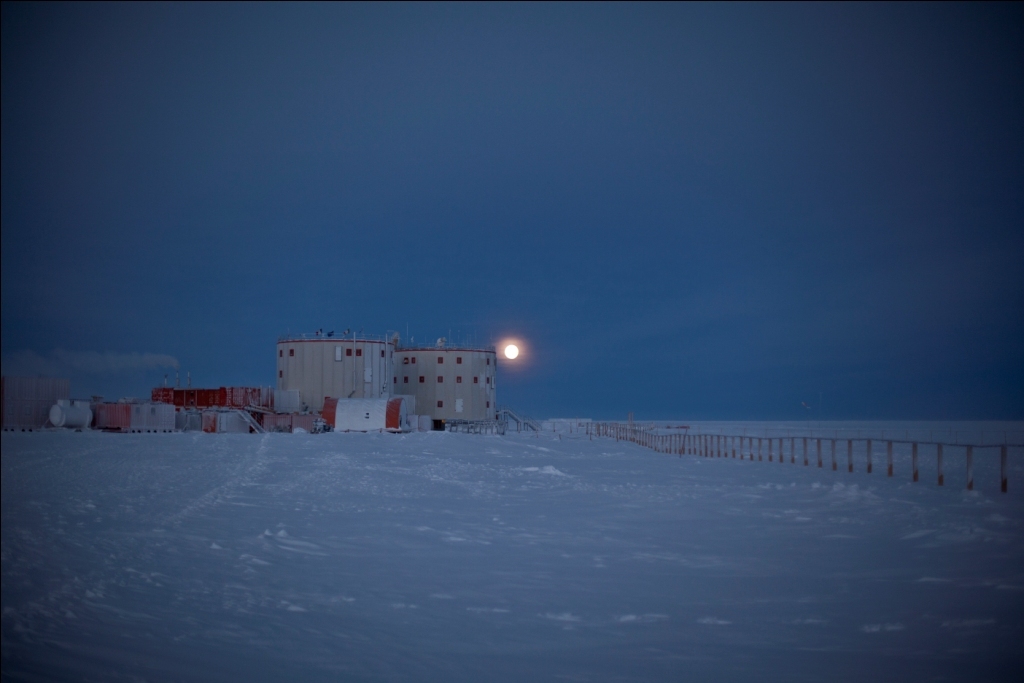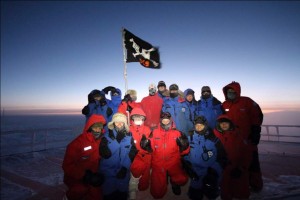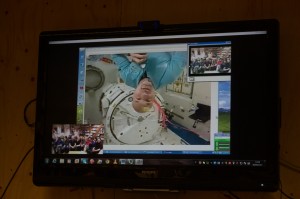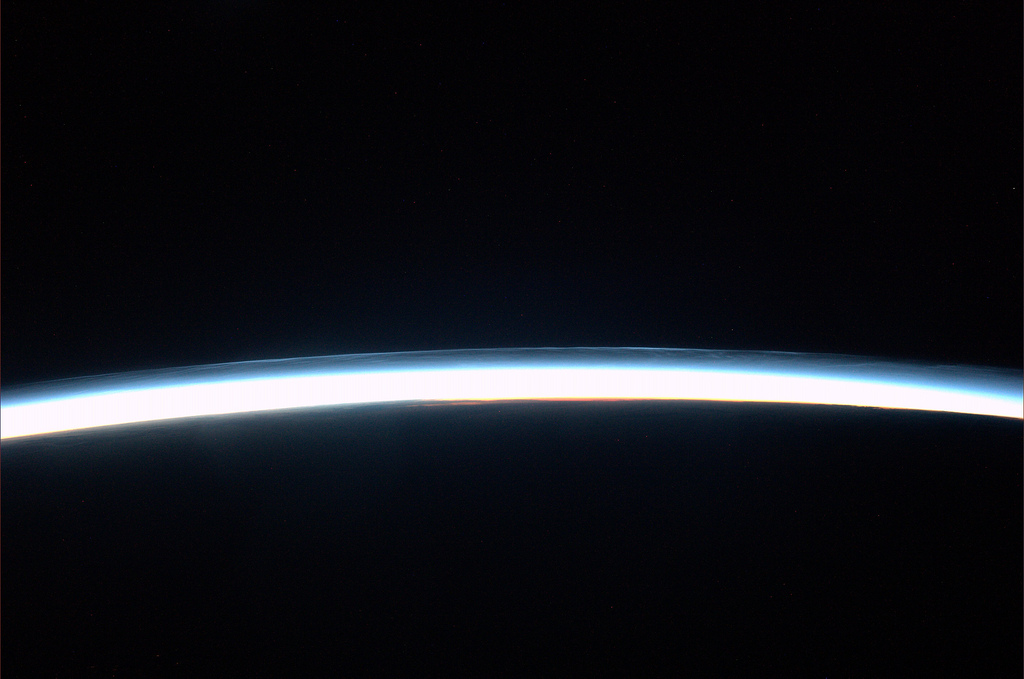The International Space Station’s orbit allows us to see most of Earth’s surface, but an unavoidable line inhibits our view beyond the horizon. Among the areas that we will never see from our privileged point of view are the Earth’s Poles. Our vision skims the polar circles, but stops around the 70° latitude making those fascinating, unexplored and inhospitable regions impossible to see.
I recently had the opportunity to get closer, albeit virtually, to this world unknown to most people, through the experience of nine extraordinary people: Anne-Marie, Antonio, Elio, Evangelos, Olivier, Helene, Albane, Luigi and Simonetta. I was warmly welcomed at Concordia, the Italian-French research station in Antarctica.
Through a satellite connection, ESA organised a meeting between two extreme environments, the Space Station and the Antarctic station, distant yet strangely similar. As we talked of experiments, research and technology, we realised that despite the physical distance, our experiences are linked by the same passion, like a flame that overcomes obstacles and barriers, setting fire to our spirits, fueling our desires, burning fatigue and transforming our experience.
I observe the faces on the small screen one by one, they are all open and friendly these explorers of the boundaries of the world, and I imagine them relaxing at the end of a day’s work, warmed by a nice shared meal in the common room: behind them I see shelves full of books, a table, dishes, ordinary objects that become extraordinary when I think about where they are. I greet them as if I am one of them, and the familiarity of the language of explorers helps me relax and enjoy the conversation. I forget where I am as I try to answer their questions and ask mine in turn. I am intrigued by the similarity of our experiences. Many of the physiology experiments they are conducting are comparable to those that we carry out on the Space Station. They too suffer from the separation of loved ones for many months, and many of their ingenious solutions to living in isolation remind me of ours on the International Space Station.
We talk a lot and when the time was almost up one of them asks me if I have ever seen an aurora. I tell him that I have, and in particular I saw one of extraordinary brilliance and beauty only a few weeks ago: a phantasmagoric choreography of emerald and turquoise, iridescent and sinuous, ever-changing and perfect. I sense enthusiasm and emotion in his voice when he answers that they too have seen it – and it was strange to think that we shared this common experience thousands of miles apart.
The communication link breaks so I don’t have time to add a thought that occurs to me after a moment of delay: every time we look into the sky and we admire the same stars, we share the same experience with all those who still know how to dream.







Discussion: 38 comments
Quando ti leggo, in post come questi, sorrido… (ogni tanto capita. Ahahah)
In primis perché scrivi da Dio, e poi perché mi “catapulto”, letteralmente, in ciò di cui parli, anche se a me sconosciuto. Trascinata dalla descrizione, dalle parole, da te.
Ogni nuova esperienza serve a crescere, a maturare, va vissuta e conservata, come un tesoro prezioso. Metti anche questa in valigia, Lù! 😉
Sarà enorme quel bagaglio che scenderai, farai fatica anche a chiuderlo… ma sai che ti dico? Lascialo aperto. Appena toccherà il suolo, tutto questo prenderà ancora più vita.
E comunque, si ricordi che, anche noi abbiamo vissuto un’esperienza comune da migliaia di chilometri di distanza, Maggiore! Ti pare poco condividere sei mesi, vedendo e provando tutto quello che stai vivendo tu? 😉
Grazie a te il mio bagaglio è ancora più grande del tuo, perché non ero preparata. Non avevo nemmeno calcolato lo spazio necessario per accogliere tutto questo. Chi se lo aspettava? Tutta ‘sta “roba” da conservare, da custodire. Una cosa è certa: io non voglio scendere…
Bacione : ))
Ciao Angela, quello che hai scritto era riflesso nelle ultime tre righe di questo racconto, che per qualche motivo non ci sono. Al piu` presto cerchero` di correggere l’errore, ma nel frattempo eccoti l’anteprima di quello che doveva essere il finale: “Cade il contatto satellitare, e non riesco ad aggiungere un pensiero che mi sovviene con un attimo di ritardo: che in realta`, tutte le volte che guardiamo verso il cielo, e ammiriamo le stesse stelle, condividiamo la stessa esperienza con tutti coloro che ancora vogliono e sanno sognare.”
Come vedi, a volte le parole non servono, tutte. 😉
Ho imparato da piccolissima a sognare, per necessità, vuoi che smetta adesso? Non ci penso proprio.
A guardare le stelle, la Luna, a parlarci…
Ad aggrapparmi al bello, al magico, all’impossibile… Diciamo che, in questi mesi, qualcuno mi ha portato tutto questo più vicino. Te l’ho detto: io non scendo.
PS: grazie!
La stessa cosa che ho pensato io: non voglio scendere!
La scoperta della (vostra) vita extraterrestre é stato un sogno….deve per forza finire????
Luca, temo la tua famiglia non sarà molto d’accordo, ma noi ti vorremmo tenere lassù ancora per molto! Paradossalmente, quando sarai qui, ci mancherai!!
A presto.
Oriana
La MIA bandiera….bellissimi ricordi!
Come la tua bandiera??
E’ quella del DC9! Fatta quest’anno!
Ciao
Il fatto caro Luca è che tu non finisci mai di stupirci e di farci sentire, come vicino, tutto quello che in realtà è lontano!
Parole tue: “una fantasmagorica coreografia di smeraldo e turchese, cangiante e sinuosa, mutevole e perfetta.”
Questa immagine mi fa sognare e soprattutto immaginare.
Ritrovo poi con piacere, dulcis in fundo, la tua fotografia che ritrae l’alba spaziale e ti ripeto con piacere e convinzione che questa tua foto passerà alla Storia!
Ciao. Rosetta
Thank you Luca.
Your blog reveals a deep sensitivity and a poetic nature which, once again, reminds me of the writing of Colonel Hadfield. How wonderful that you and the residents of Concordia had the chance to compare your experiences; you are special people.
I’m constantly surprised and delighted that you take time and effort to share your life in the ISS with us.
Thanks and good wishes from Fran in Cardiff
Sei un grande Luca …ti seguo con interesse !!!
Un caldo abbraccio a tutti coloro chi aprono le porte e trovano intorno freddo o buio… ma il vostro lavoro e importante per noi che abitiamo confortevole
Ti seguo da poco e comincio a capire un po il tuo rapport con noi in terra ‘ferma’. Quindi siamo entrambi ‘Astronouts’! Certo noi abbiamo la ‘gravita’ e lei non tanto. Comunque non ti invidio data l’incidente recentemente con l’acqua nel tuo visiere. Insomma come fate voi a acettare che non solo voi siete senza gravita’, ma tutto attorno voi tutto galeggia in area senza un anticipo dove si va a finire. Orgoglioso di avere un Italiano nel spazio. Good Luck Luca!
Ho sentito il calore reciproco della vostra comunicazione pur trovandovi in due contesti così naturalmenti freddi…
Cosa da aggiungere alla lista della Vita: non è il luogo che da calore, sono le persone.
красивый.
Grazie ancora perché io con i tuoi racconti sto a momenti nell’ISS e subito dopo nell’Antartide… due esperienze “estreme” ma a sua volta simili! Con affetto
Ti rendi conto che quello che scrivi così bene delle tue esperienze ne dai una illustrazione così entusiasmante che è come se l’avessimo vissuta anche noi” quella aurora smeraldo e turchese, così cangiante, sinuosa, mutevole e perfetta la vedo davanti ai miei occhi e ne rimango stupita e meravigliata, E vero la similitudine del vs: lavoro, così lontani x mesi dai Vs: affetti, ma sento che è grande anche la vs. gioia per ciò che riuscite a fare, per il grande lavoro che portate avanti con molta capacità. buona continuazione a Voi tutti ed anche a quelli al Polo, ed un ringraziamento per il lavoro che svolgete. Un saluto
It´s a shame those guys aren´t much on social media. I´m sure their experiences are also very interesting, but I´ve only seen a couple of entry blogs from them. You should have told them to join Twitter 😛
Your last thought made me smile. When I was a child I remember lying on the backyard of my granparents´ house in the countryside where I could see the sky full of stars, and I used to wonder how many people in the world were looking at the same stars as me in that very same moment. It´s magical to know that people from very distant places can be looking at the Universe the same as you are. And who knows if someone in any of those stars is looking back at us 🙂
Con queste immagini siamo tutti in orbita. Grazie.
Funny you should say that, Vanessa. When I posted this blog, for some reason, three little lines got left out for some reason I can’t understand. I’m working on fixing it, but here they are, a preview for you: “We lose the satellite contact, and I can’t express a thought that comes to mind a second too late: truly, every time we look towards the sky, and admire the same stars, we share the same experience, with all those who still want and know how to dream”
Yes, I could read those lines when I read your entry, that´s what reminded me of that similar thought from my childhood 🙂
Sono sempre emozionata quando leggo quello che scrivi perché mi sento partecipe di quello che provi tu Luca, inoltre le immagini che ci trasmetti dalla tua invidiabile postazione ci fanno sognare di essere al tuo stesso posto. Grazie!
i sogni….senza quelli non ci sarebbe futuro.
ciao Luca,
io credo che sia sempre così nella vita. Ci sono persone vicine fisicamente ma che sentiamo lontane anni luce da noi e persone fisicamente lontane – non necessariamente anni luce – che sentiamo vicine, e magari senza tantissime parole ti sanno raccontare un mondo e tu ti ci ritrovi dentro. Tu sei anni luce ma quando mandi una foto fai sentire l’emozione che ti ha dato, quando racconti del tuo lavoro trasmetti la passione che ci metti, quando parli dei tuoi affetti trasmetti l’amore profondo che provi ed io – ma penso tutti – ti sento così vicino, come un amico vero, di quelli che anche se non vedi da una vita sai che ci sono. Pensa te, addirittura non ti ho mai visto! Ma mi dai infinitamente di + di tante persone che vedo tutti i giorni. Penso che questa sia una fortuna ed una delle cose belle della vita. Con amicizia, Orietta
Ciao Luca , come ho scritto su twitter ricordo molto bene il giorno in cui sono incappata nel racconto di Litterio sul sito dell ‘ Esa , effettivamente il pensare a un avventura senza alcuna esperienza simile non é cosa facile , ma leggere le parole di un protagonista ti apre davvero uno scenario incredibile , la mente inizia il viaggio , le immagini si fanno vivide e fantastiche , le emozioni crescono e quell avventura diventa quasi tua… da quella pagina mi sono avventurata su Human Spaceflight e là c eri tu con la tua attesa per la missione #Volare… Non pensavo di lasciare così presto la Stazione Antartica per la ISS , ma qualcosa ha deviato la mia rotta … Così eccomi ancora in volo , e con il Maggiore ! 😉 “Meraviglia” …
E’ bellissimo pensare che, seppur da posti diversissimi e in condizioni non sempre facili, il cielo ha ricevuto lo sguardo di ogni uomo che sia mai esistito sulla Terra. E in quel guardare il cielo ci sono i desideri di ciascuno di noi…
Un saluto a te sulla Stazione e agli amici in Antartide, e buon lavoro 😉
… E forse sta proprio in quelle ultime 3 righe del tuo racconto, il segreto del successo della Missione Volare.
Avresti potuto vivere in solitaria questa tua esperienza straordinaria, o condividerla solo con colleghi ed amici più cari.
Hai scelto di essere il trait -d’union tra il cielo ed un’Italia che, nonostante quel che accade, sceglie di sognare.
Ci hai preso per mano, mamme, bambini, nonnine e ragazzi, e ci hai mostrato che non bisogna aver paura di osare.
Ci hai dato un gancio a cui aggrapparci nella tempesta, per poter ritrovare la strada.
Un caro amico, uno di noi, al quale poter scrivere un giorno :
Caro Luca, grazie alle tue foto e ai tuoi racconti, ho scoperto che la vita è adesso.
Grazie di avermi mostrato che in fondo, i sogni sono i modi in cui ritroviamo noi stessi.
E allora buon viaggio, caro amico inatteso, quando lungo il mio cammino mi sentiró stanca e sconfortata, alzerò gli occhi al cielo e ricorderò un’Italia che, guardando le stelle, rinasceva e ritrovava la voglia di lottare per ciò in cui crede.
E allora mi scapperà un sorriso.
🙂
Luca, ho letto col fiato sospeso il tuo post perché sei riuscito a trasmettere attraverso le parole le sensazioni che provavi in quei momenti del collegamento, e dalle tua considerazioni si evince che altre al “iper tecnico” c’è l’uomo che si nutre di emozioni e sentimenti. Credo che sia il primo astronauta a mostrare questo aspetto. Penso che grazie a te le missioni spaziali possano avere più popolarità e consensi.
Un fotografo come me non so cosa darebbe per poter provare quell’esperienza, ma so che non sarà mai possibile e allora mi accontento di viverla in modo indiretto, attraverso le tue immagini e le tue parole. Da bambino le missioni sulla Luna mi incantavano, mi documentavo e non avrei mai immaginato che un giorno un astronauta potesse condividere con la gente le sue esperienze in diretta. Proprio oggi mi trovavo in vacanza a Meteor Crater dove è esposta luna capsula di rientro delle missioni Apollo … Averla toccata con le mani mi ha provocato una forte emozione… certo che rientrare con quell’aggegio li ci vole va fegato 🙂 …. in questo senso per te sarà un rientro molto più sicuro.
Anche se non ti conosco direttamente, ti abbraccio fraternamente. In bocca al lupo e non smettere di farci sognare.
Salvo Ilardo, Trrecastagni (CT)
Thanks Luca for this article, I’m very glad you enjoyed the videoconference with us as much as we enjoyed it with you!
For info: the first picture of this article (The Station and the Moon) was taken by Christophe Leroy-Dos Santos (astronomer Concordia DC-9)
Thanks
Albane
A volte mi dai la sensazione di essere lì con te a 400 km. dal suolo.
E’ un attimo, ma molto intenso.
Grazie Luca!!
Ho vissuto anch’io un’aurora spaziale. Grazie a te, Luca
Hi Luca!
It was very kind of you to post about our connection a few days ago! Once more I have to tell you that for us it was also an unforgettable experience, especially the moment you showed us the view of our planet from the ISS window!
Indeed many of the challenges we face here are quite similar to the ones you have to deal with while in orbit and to learn about the details of your everyday activities in the station was more than interesting for all of us. The boundaries of human exploration are continuously expanding and perhaps the places we live and explore are two of the most characteristic examples of the never ending quest for answers even at the most extreme environments… I just hope that these missions can only inspire the mankind for more endeavors in these fields instead of spending resources on war and other irrational activities…
Once again, thank you for your patience and your analytic response to all of our questions. It was an honor for us!!
Your friends from Concordia
Ancora una volta mi hai trasportato in un altro mondo con le tue splendide parole Luca, e immancabilmente anche i commenti di Angela. Un attimo di silenzio per inviare un sogno, una lacrima, una soddisfazione alle stesse stelle che stanno intorno a te. Ripenso al breve collegamento con te, via radio, che mi ha fatto sentire per un attimo a bordo della ISS, un sogno di radioamatore che si è avverato grazie alla tua disponibilità, una spinta ad insistere per cercare di avverarne altri; ora i miei sogni sembrano più al sicuro grazie a te, che li custodisci lassù in attesa che io riesca ad avverarli. Grazie. Carlo. IK4JQQ
Io non ho un Dio in cui credere. O, per lo meno, non uno di quelli che frequenta Chiese, Sinagoghe o Moschee. La filosofia che mi sono costruito mi permette di vivere i miei 64 anni con una buona dose di serenità. Spesso, nelle notti serene, alzo lo sguardo e sogno. Mi perdo tra neutrini, bosoni o quanti di luce che arrivano da milioni di Km. pensando che “questi” hanno vissuto per altrettanti milioni di anni per giungere fino qui da me. Poi leggo da qualche parte che se un fotone non incontra un ostacolo non “muore” mai.
Allora la mia mente impazzisce. Vorrei sapere tutto ciò che abita l’universo e mi ritrovo da capo. Dov’è Dio ? In un sasso? In un’albero? nelle rughe di un vecchio o nel sorriso di un bimbo? Sull’ ISS o nell’angar del Concordia? Dentro me e dentro tutto e tutti? Ora che lo sto scrivendo mi sembra un discorso ingenuo, ma è questo che penso e questo che trasformo in parole scritte. Qui su questo blog. Non mi chiedo perchè lo faccio. Lo faccio e basta. Mi serve ad aprire quello che alcuni chiamano “anima” e a svuotarla da concetti che la cultura occidentale ha intriso di Cattolicesimo e con questa anche me. ( nulla di personale rispetto a chi crede.)
Un GRAZIE a te Luca, mi hai fatto “vedere” un altro aspetto di ciò che è madre natura.
I winter-overed a few years ago at concordia and we had a similar audio conference with ISS crew. We felt exactly the same you describe !
Luca, quale ricordo di noi porterai con te quando ripenserai a questa esperienza?
Ti arriva il nostro sincero affetto, la nostra stima?
il vostro affetto sara` per sempre un ricordo che mi scalda il cuore.
Ciao Luca, ho potuto leggere del collegamento che hai fatto con gli amici ed i colleghi della Stazione “Concordia”; un posto che io conosco molto bene e che, per molti aspetti, sappiamo quante similitudini con la vostra realtà sull’ISS.
Ma quello che più di tutto mi ha colpito del tuo scritto in merito al vostro collegamento sono le ultime tue parole: “…..con tutti coloro che ancora vogliono e sanno sognare”, la stessa frase che campeggia, scritta da una giovane ricercatrice in una delle vecchie costruzione dell’altra nostra base in Antartide, a baia Terra Nova
This is very interesting, Luca. I imagine it to be a very cold stay at the south pole. Brrr. But I bet the aurora is incredibly gorgeous at the south pole and from the ISS.
I saw the aurora only one time in my life. I was 16 or 17 years old. I was in the house and my mom called me outside, “Lorna, come out and look.” I was busy doing something. She repeated the urgent call. Being a teen ager, I was a bit annoyed at the interruption and responded, “What do you want?!” She repeated the request. Still a bit annoyed, I said, “Why do you want me to come outside?” She coaxed, “Well just come out and look.” I went out. “What, mom?!” She was excited, “Look at the sky.” I looked northward as directed. I saw vertical beam-like flashes of light. I asked her, “Is someone having a sale?” I thought it was those huge commercial lights that car dealerships use to attract customers. She laughed and said, “No, its the aurora borealis” Suddenly I felt like a toddler again discovering something new for the first time, a long forgotten feeling. “What is that?” I asked. Mom repeated, “The aurora borealis.” I said, “I know you said that, but what is that?” Mom, “the northern lights.” My thoughts were that those were some strong electrical lights which resulted in the question, “What is that?” And again I heard, “aurora borealis.” I started laughing, “I know you said that, but what causes it?” She gave it her best shot and said it was the reflection of the sun off the snow at the north pole.” Now, I know that was not quite right. But then, I was looking at her in disbelief and amazement. “Really? Wow!”
It is rare that we get to see the aurora in southern Michigan. I have seen utube videos of the aurora in Canada and they look amazing. I have also seen videos of aurora from the ISS and that looked incredible. I hope the south pole crew and you all got great photos of the event!
I miss Live ISS. I hope the government shutdown ends soon. Hope all of you are doing great up there. Enjoy each moment because times flies and before you know it you will be back on earth at home. Peace and Love to all of you on the ISS.
Lorna
Carissimo Luca, mi hai fatto venire i brividi.
Tra pochi giorni sarò in Antartide come giornlista al seguito della missione italiana ENEA-PNRA e sognavo di poter realizzare, con l’aiuto di ESA, un contatto tra te e Concordia, anche per divulgare le attività scientifiche italiane sulla Terra come nello spazio. Purtroppo non c’era compatibilità tra i tempi del mio arrivo in Antartide e quelli del tuo rientro a Terra.
Sono felice, veramente felice che comunque siate riusciti a parlarvi.
Un abbraccio.
Giorgio
Dear Luca,
Thanks again for this meeting. The most interresting we had so far away !
Concerning the photos’ credits, please, raffaella, insert the credit on the two first pictures like you did for the others.
The firs is mine, Christophe Leroy-Dos Santos.
The second one (DC9 crew) has been made by Yann Reinert.
Thanks in advance,
Christophe